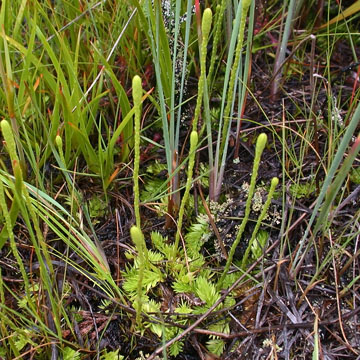

Pseudolycopodiella caroliniana - (image 1 of 3)
Taxonomy
Family: Lycopodiaceae
Habitat
Acid bogs and wet sandy pine-barrens, often with sphagnum.
Associates
Distribution
MA (extirpated) and Long Island to FL and TX, mainly on the coastal plain, rarely inland and interruptedly pantropical.
Morphology
Sterile (horizontal) stems creeping and rooting, to 10 cm, branched, about 1 mm in diameter, dorsiventral with 6-ranked leaves, the 2 lower ranks spreading and appearing lateral, lance-ovate, to 7 mm long, acuminate, entire, the upper 4 ranks erect, much smaller, lanceolate, to 5 mm, attenuate; erect stems 10-30 cm, terete, about 1 mm diameter, with leaves scattered, equal, bract-like, linear-subulate, to 5 mm, ascending or appressed; strobili soliatary, 2-12 cm long and 5-7 mm diameter; sporophylls yellow-green, broad-based, with subulate spreading tips.
Notes
Spores produced September to October
Wetland indicator: FACW
The relatively long spreading leaves give the stems of this species a more flattened appearance relative to species in the genus Lycopodiella.
References
Gleason, Henry A.
and A. Cronquist. 1991. Manual of Vascular Plants of Northeastern United States
and Adjacent Canada. Second Ed.
The New York Botanical Garden. Bronx, NY.
|
Michael Hough © 2018 |